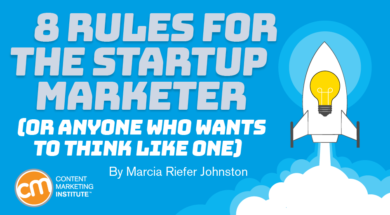If you work in a big, established company, a presentation on being a marketer on a small team, especially a small team in a startup, may not seem to apply to you. But the wisdom 2015 Content Marketer of the Year Vishal Khanna has to share extends to anyone who wants the flexibility and performance possible when you act like a startup marketer.
For most of his 15-plus years in marketing, Vishal has been his organization’s only resource for marketing, communications, and media relations. “Everywhere I’ve worked, I’ve had a low budget, no staff, no resources, and limited access. In that situation, you’ve got to be creative,” he says.
Whether or not you think of your company as a startup, put on your startup-marketer hat, and consider which pieces of Vishal’s advice might make all the difference for you.
Unless otherwise noted, all images and quotations in this post come from Vishal’s Intelligent Content Conference talk How to Connect Your Content and Technology to Your Business Goals with a Small Team (which he told his audience he almost titled “Straight Outta Locash”).
1. Build a simple system that frees you to do extraordinary work
“Be regular and orderly in your life … so that you may be violent and original in your work.” Quoting Flaubert is Vishal’s way of telling marketers, build a simple system that frees you to do extraordinary work.
The kind of system he’s talking about is the process that supports what your marketing and sales teams want to accomplish. Without endorsing any particular tools or approaches, he gives a couple of examples of what this type of system might look like from his experience.
Here’s one:
This example comes from a situation in which a market researcher checked LinkedIn’s Sales Navigator and qualified all the leads that came in to a medical research organization Vishal was working for, answering questions like these: Who are they? What are their characteristics? What companies do they come from? What are their interests? What drugs are they developing?
The team used MailChimp to first communicate with leads via email. When people opted in to a certain level, the marketing team put their data in Pardot, which initiated automation programs. “When they were nurtured enough,” Vishal says, “we’d shoot them over to Salesforce, where our sales team would take over and aim for the goal, which was of course a big pot of money at the end.”
Here’s another example:
This system includes the following tools:
- Hunter, an email verifier into which you can toss an email address to find out if it’s a valid address (Such verifiers are limited in their reliability, he points out.)
- Winmo, a database that includes many contacts in the pharmaceutical industry as well as a lot of market research (“I didn’t have the resources to hire someone to do this research. I had to find tools that can mimic that as well as possible,” Vishal says.)
- SharpSpring, an automation program at the heart of the system (“I’m not advocating for them. You put your automation program in the center. Make sure every single thing around that is integrated,” Vishal says.)
- AdButler, which runs the display ads
- Unbounce, which has his landing page
- Salesforce, into which all of these integrated tools push leads. (“When we push a lead over to Salesforce, everything that lead ever did has to transfer over,” Vishal says.)
Whatever tools you choose, make sure that they work together. As Vishal says:
Find an automation program that matches with your sales platform. Make sure that data follows over. If you don’t, every time you push a lead over to Salesforce, you’re going to have to send an email saying, ‘Hey Greg, this person downloaded our white paper and then went to these three pages.’ Your system has to get that intelligence to your salespeople automatically so that they know what to do without anyone having to send that email.
Find an automation program that matches your sales platform, says @bediscontent.
Click To Tweet
Vishal’s observations line up with the Content Marketing Institute’s latest research, which Lisa Murton Beets recently summarized (bolding is mine):
Eighty-eight percent of top performers value creativity and craft in content creation and production, compared with 74% of all respondents. In addition, 70% of top performers rate project management flow of their content-creation projects as ‘excellent’ or ‘very good’ versus only 36% of all respondents. As you can see, most respondents value creativity and craft. Where successful content marketers seem to have an edge is that they have good processes.
Successful #content marketers that have good processes have an edge over those that don’t. @marciarjohnston.
Click To Tweet
No one process or system is ideal for every situation. Find the right tools and the right flow to manage your lead-nurturing process in relation to your content engagement. Develop separate processes as needed to cover distinct categories of leads; for example, Vishal used categories like digital marketers, life-sciences consultants, pharma directors, agency leaders, innovations directors, and brand managers.
But don’t overcomplicate things. “Make it a simple system that you can manage – and then be extraordinary in the content you develop and push out there and the strategies you implement,” Vishal says.
2. Be passionate about your work
No system in the world can make up for a lack of passion for what you’re doing with it. Passion is critical to the success of any startup (or any business). That may seem to go without saying, but the reminder is worth repeating to keep our focus where it belongs: on making a difference for the people we create our content for. As Vishal explains:
You have to be passionate about what you do. I probably think about what I do half of the time I’m not working. I’m constantly trying to figure out how to make things work better. I take personally what I do. If I didn’t believe in my brand, I wouldn’t be able to do what I’ve done.
While people working in startups often have the extra motivator of having “a chunk of ownership” of the company, anyone in any company has an opportunity to dig deep and bring passion to the job.
What does it mean to “be passionate” in your job? Beyond a feeling or conviction, passion shows itself as persistence, a willingness to put in the work to achieve goals worth achieving.
In Vishal’s case, passion might mean finding creative ways to do his own market research. It might mean looking at each lead and devising his own ways of hunting down lead sources from every corner of the organization. He goes after the data he cares about so that he can make good decisions regarding his budget and his time.
“You have to dig in. You have to do the dirty work,” Vishal says.
3. Build every web page with conversion in mind
To create a high-performance website for a startup (or any business), “Build a beast with a billion landing pages.” Vishal recommends this mindset especially for teams with limited resources – and what team’s resources aren’t limited?
Envision your website as if every single page were a landing page. Even a product-description page can act as a landing page. The trick is to think in terms of what the business goal is for each page. What do you want people to do when they get to that page? Request a demo? Something else? Clear away the clutter, and make it obvious what action each page is calling people to take in line with your targeted goals.
Define the business goals for each web page, advises @bediscontent.
Click To Tweet
Aiming at conversion on every page has two advantages:
- You get more leads.
- You streamline your website development.
For example, you might create a LinkedIn campaign that connects to existing product pages. You don’t need to develop a landing page; you already have it. You can connect that page to your ad processes. “Landing pages take a while. You won’t have to do that if your entire site is, basically, a set of landing pages,” Vishal says.
4. Target a necessary and sufficient subgoal
Any business’s primary goal is selling a product or service: closing a deal. Vishal suggests that you take a step back and ask, “What’s a necessary and sufficient subgoal that will always lead to the closed deal,” and focus on that subgoal as the goal of your content.
For example, he once worked for a company that provided preclinical research services to pharmaceutical companies. “We knew that we would never close a deal unless we got that prospect on location to see our resources,” Vishal says. Instead of focusing on closing the deal – the ultimate goal – Vishal aimed for the one-step-back goal of getting people to visit the research campus. He moved the content’s goal line back to a necessary and sufficient subgoal of the primary goal.
One common necessary and sufficient subgoal for marketers is having someone request a demo. This subgoal – requesting a demo – becomes your target, not closing a deal.
Vishal uses a tournament bracket as an illustration of how you might visualize a necessary and sufficient subgoal as the target. (A graduate of University of North Carolina, he claims that he doesn’t know how the Tar Heels logo got there in the middle of this bracket.)
This logo represents your target, in this case, the request for a demo. After you determine this target, consider what subgoals and sub-subgoals could lead to it. As Vishal says:
These are no longer necessary and sufficient goals. These could be things like downloading a white paper, reading an e-book, or visiting three key pages. Your strategy is to develop and distribute content that hits these subgoals as you aim for your target.
5. Streamline your processes
One of the biggest advantages startup marketers have is their ability to get things done quickly. For example, Vishal’s review process right now is one person: himself. “I don’t have to go through anybody else. That’s amazing. This is the first time I’ve ever had the independence to own what I do and not have to go through eight other people,” he says.
In this situation, Vishal can change tactics quickly. He did just that after conducting an experiment that led him to discover that display ads were likely to cost about $900 per conversion, far higher than the industry standard of about $130 per conversion. “I killed display ads right away,” he says. Vishal shifted most of the advertising spending to LinkedIn, where ads cost only about $25 per conversion – without having to get anyone’s approval.
While marketers in large companies may not have the luxury of that kind of independence, they can look for opportunities to streamline their processes – for example, keeping the number of approvers to a minimum – to stay as nimble as possible, to pivot and change quickly.
Keep the number of #content approvers to a minimum to pivot and change quickly, says @bediscontent.
Click To Tweet
6. Discover an engagement cadence that works
Vishal said something that took me a bit of wrestling to understand: “Your content is prose, but your workflow is poetry.” Here’s the visual he uses (from Autopilot) to illustrate this point:
He means, “You’re working in a time-space to engage your prospects. Trust your instincts and the idea of rhythm and cadence. Find a cadence that works.”
Say you are going to engage a prospect over eight weeks. Ask, how often do you want to reach out? What kind of connections do you want to make and how often? What tone should they have? What do you want those touchpoint patterns to look like?
Vishal advises not to “get caught up in the technical side,” suggesting that the cadence of communications with prospects can be “beautiful.”
As with poetry of any kind, there’s no formula for achieving what Vishal is talking about. The value in his advice isn’t in how-to instructions but in the assurance that this kind of beauty and workability is possible to achieve.
7. Build relationships with experts while building your own expertise
Startup marketers (not unlike their big-company counterparts, although perhaps with more urgency) must not only find experts to work with but also become experts themselves. “Read about your product, your service, your industry. Learn everything you can. What you can’t do, hire someone who can,” Vishal says.
For example, he spent months learning about patient adherence: “I know all kinds of statistics about it. I can speak about it in public. What I don’t know is how to analyze the statistical data. So, I hire that out.”
In short, become the expert yourself where you can. Where you can’t, call on the expertise of others.
8. Forget perfectionism; improve continuously
Vishal quotes John Updike’s line, “Perfectionism is the enemy of creation.” Vishal describes his own novel, which he supposedly finished eight years ago. “It’s still sitting around. I work on it and work on it and work on it. It’s never going to get out there if I don’t put it out there,” he says.
Marketers can get caught up in the same impulse to create ideal pieces of content.
You have the people you have. You’re in a box. Use your limitations to your advantage. Forget perfectionism, and aim for conversion. You need to have a piece of content that’s good enough to solve your goals.
Once you publish an imperfect piece of content, you have an opportunity to make it better with the input of your audience. Iterate. Observe. Measure. Improve. “Put it out there in the world and see what it does. As it works in the world, change it to make it better,” Vishal says.
Conclusion
What strikes me about Vishal’s advice to startup marketers is that anyone can be a startup marketer. It’s a mindset, not a role defined by circumstances. No matter how big your team or company, you can apply creativity, openness, and gumption to get things done that might not seem possible at first glance.
How have you brought a startup mentality to your marketing job? Please share an example of a time when your own creativity, openness, or gumption made a difference.
Here’s an excerpt from Vishal’s talk:
Please note: All tools included in our blog posts are suggested by authors, not the CMI editorial team. No one post can provide all relevant tools in the space. Feel free to include additional tools in the comments (from your company or ones that you have used).
Make plans today to attend the 2018 Intelligent Content Conference March 20-22 – and get the biggest registration savings. Sign up now.
Sign up for our weekly Content Strategy for Marketers e-newsletter, which features exclusive stories and insights from CMI Chief Strategy Adviser Robert Rose.
The post 8 Rules for the Startup Marketer (or Anyone Who Wants to Think Like One) appeared first on Content Marketing Institute.





No comments:
Post a Comment